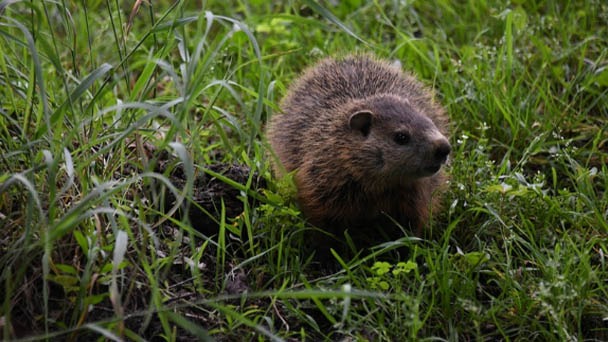How to Get Rid of Groundhogs Under House Effectively
Written by Ivy
Jan 30 2023

Learn how to naturally and humanely get rid of groundhogs if they are damaging your garden. You can try a variety of commercial and homemade groundhog deterrents. The groundhogs can be quickly eliminated, and they can be kept out of your yard. The techniques listed below can be used to get rid of groundhogs.
- Epsom Salts
- Castor Oil
- Human Hair Clippings
- Soiled Kitty Litter
- Offensive Scents
5 Natural Ways to Get Rid of Groundhogs
Epsom Salts
The groundhog will stay away if Epsom salts are scattered around the burrow's entrances or exits. Try setting a tin pie plate filled with the salts close to your plants if they are being eaten. Replace after a rain.
Castor Oil
Castor oil can be used to deter them from making burrows because they dislike the smell; however, you should only use it when you are certain that no animals are present because otherwise, the animals will continue to dig their burrows. To find out when they go looking for food, you'll need to keep an eye out.
Human Hair Clippings
Because groundhogs don't like the smell of humans, hair clippings from your neighborhood barber or hairdresser may also work well to deter them. In the groundhog's favorite spots, scatter clippings. You can also put the trimmings in a fine mesh bag and stake it up close to the groundhog's home to prevent it from blowing away in the wind.
Soiled Kitty Litter
Because it smells like a predator, used kitty litter spread around one of the den holes—but not the other—is also effective. They can escape rather than remain underground by leaving one exit hole unscented.
Offensive Scents
Groundhogs hate some smells more than others. If you can ensure these smells are present near their burrows and around the garden, you may be able to send them packing:
- Cayenne pepper – Our Farmers' Almanac readers swear by this method: Simply pour cayenne pepper close to the groundhog's holes. So that you can make a small pile, purchase a sizable container (bulk size). You'll need to reapply if it rains or is windy. It's actually the smell and the heat they don't like. To prevent them from nibbling, you can also spray tender plants with a solution made of 2 teaspoons cayenne and 1 quart of water.
- Garlic – To prevent groundhogs from entering certain garden areas, crush some garlic cloves and apply the paste there. The strong smell overwhelms their delicate noses.
- Lavender – Consider adding some lavender to your garden. While it smells lovely to us, groundhogs find it offensive and avoid the areas where it is. Additionally, they don't like the scent of the following herbs: basil, chives, lemon balm, mint, sage, thyme, rosemary, and oregano.
About Groundhogs
Groundhogs, also known as woodchucks, "whistle pigs," or marmots, are rodents that can do a lot of damage to your lawns and gardens. Because they are skilled diggers (their dens can be extensive tunnel networks with chambers, hallways, and multiple exits), they can weaken the soil, leading to damage to foundations, barns, and farm machinery as well as potential harm to livestock. The labor-intensive work you put into your garden could be completely destroyed in a single afternoon because groundhogs, which are herbivores, like to eat the plants in it. They certainly make a nuisance of themselves.
So what can you do? If you don't have a dog, or you don't feel comfortable trapping and releasing* (or don't have the resources to), read our list of 5 efficient, natural solutions to help keep them out, below. The groundhogs themselves, household pets, or the environment won't be harmed by these suggestions.
- Also Read: What Do Groundhogs Eat

Are Groundhogs Dangerous?
Groundhogs typically pose no threat to humans. They are usually not a big threat to people, despite the fact that they can certainly wreck havoc in gardens or destroy crops.
Although they are possible, groundhog attacks are incredibly uncommon. A groundhog would typically much prefer to stay away from someone than engage in conflict with them.
But that doesn't rule out the possibility of a groundhog posing a threat. While they generally avoid people, if they feel threatened and have nowhere to hide, they may turn hostile. Additionally, they are capable of spreading the deadly disease rabies to people.
Groundhog burrow entrances can undoubtedly be unsightly when they are on private property. A burrow may also endanger a building, such as a deck, shed, or house. A structure could sag, deteriorate, or even collapse if the hole or tunnel network compromises ground integrity.
Burrows may also pose a physical risk to people. An injury to the leg or ankle, for example, could result from unintentionally stepping into an entry hole.
Overall, groundhog related injuries are rare. Likewise, structural damage is not common. But it's all conceivable.
What Are Groundhogs Afraid Of?
Generally speaking, anything that a groundhog perceives as a potential predator will make them nervous. Along with humans, groundhogs will typically run from other predatory animals. Home pets like dogs and cats can fall under this category, as well as wild predators like wolves, mountain lions, and coyotes.
How to Prevent a Groundhog for Burrowing under Deck and Shed
Fencing
Mesh steel fencing is among the most cost-effective ways to keep groundhogs from digging in a specific area. They won't be able to move toward your deck or shed because of the physical barrier you'll build.
In many cases, your best bet is to create a fence that's partially above and partially below ground. They may not be able to climb over or dig through if it is three feet above and below ground level, but that may be enough to prevent them from entering the area you want to keep secure. Just make sure that the top and bottom curve outward (away from your deck or shed) to make it harder to climb over or dig under.
Fencing can be used to enclose abandoned burrows. The ability to locate former residences, both their own and those built by other animals, is a strength of groundhogs. You can increase the likelihood that they will choose another option by blocking the entrances with wire fencing so they can't get back in.
Remove Food Sources
If there are no suitable food sources in your yard, groundhogs might choose to dig their burrows somewhere else. This means that if you have a garden, you must keep it far away from your shed or deck. You also want to keep any other plants that a groundhog may wish to turn into a snack away from your structures.
Additionally, reducing a groundhog's food sources can be accomplished by treating for insect pests. As was already mentioned, groundhogs will consume grubs, snails, and other insects. Groundhogs won't be as interested in your yard if you keep those pests under control because there won't be as much food available.
Also Read How to Get Rid of the Following Species:
Animals:
- Ant
- Brown Recluse Spiders
- Hornets
- Palmetto Bugs
- Spider Mites
- Water Bugs
- Black Caterpillars
- Grass Flies
- Carpenter Bees
- Beetles
- Scorpions
Conclusion
Finally, you shouldn't be considering how to remove grass from beneath a shed or deck any longer. Many of the options above are viable and fairly simple to execute. The vast majority are also incredibly humane, ensuring that the groundhog suffers little to no harm.
However, you can always hire a specialist to ensure the job is done correctly if you're unsure. Professionals are aware of how to handle the circumstance while ensuring the security of all people and animals involved.
FAQs
How to Get Rid of Groundhogs under Deck
The most effective remedy to get rid of a groundhog denning under your shed or porch is by trapping and removing it. The use of live traps to catch and relocate groundhogs is popular and it is known to be very effective. A live trap can be rented or purchased because they are widely available.
Will Vinegar Get Rid of Groundhogs
Pour the ammonia solution down each hole after combining it with soap, vinegar, hot pepper, and laundry detergent. Up until the groundhogs leave, this might need to be repeated several times.
Will Mothballs Keep Groundhogs Away
Mothballs are another effective way of repelling groundhogs. Groundhogs dislike the smell that mothballs, which are made of naphthalene, produce and can detect even at very low concentrations.
Latest Updated
- Does Peppermint Oil Repel Spiders - Get Rid Of Spiders
- Does Cornmeal Get Rid of Ants - How to Use It
- How Do Exterminators Get Rid Of Mice In Walls - Is It Work?
- How To Control & Get Rid of Nutsedge
- How to Get Rid of Groundhogs Under House Effectively
- How To Get Rid of Ant Bites Overnight - Home Remedies
- How to Get Rid of Brown Recluse Spiders - 2023 Guide
- How To Get Rid of Hornets with Simple Steps
- How to Get Rid of Palmetto Bugs with Simple Methods
- Early Signs of Spider Mites - How to Get Rid of Them
Popular Articles
- Winter maintenance of Antirrhinum Majus
- How to Grow Terminalia Mantaly Tree
- How to Grow and Care for Crossostephium Chinense
- How to grow Antirrhinum Majus in spring
- Peristeria Elata (Dove Orchid) Profile: Info & Care Guide
- Underwatered Snake Plant (Sansevieria Trifasciata) - Signs And How To Fix
- How to Care for Brazilian Jasmine Plant (Mandevilla Sanderi)
- How to Grow & Care for Graptopetalum Purple Delight in Summer
- Rosa Chinensis (China Rose): Plant Growing & Care Tips
- How to Care for Baby Sun Rose (Aptenia Cordifolia)